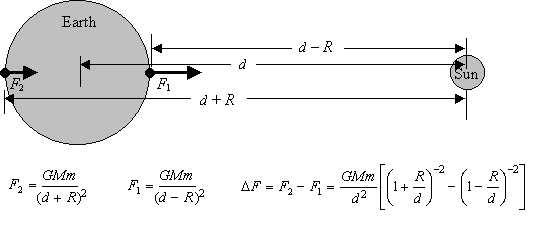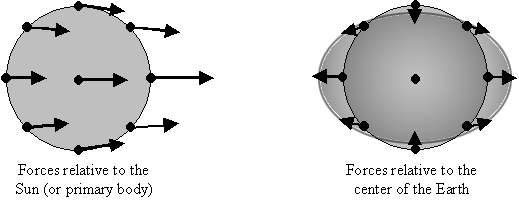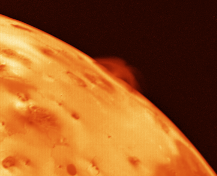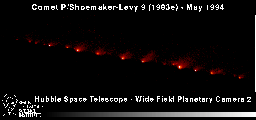| Physics 320 |
Astrophysics I: Lecture #12
|
Prof. Dale E. Gary
NJIT
|
Differential (Tidal) Forces, Precession
and Nutation
Differential Gravitational
Forces
There is a general
process that is responsible for each of the following phenomena:
The basic process is differential
gravitational forces, which means gravitational forces that are not equal
across the finite size of a body. It may seem that on Earth we should
feel the same gravitational force from the Sun anywhere on Earth, but in
fact we are 13,000 km closer to the Sun on one side of the Earth (near
noon) than when we are on the other side (near midnight). This 13,000
km may seem a small difference in the 150 million km distance from the
Sun, but even so the difference has consequences. Let's calculate
the force difference on two sides of a body of radius R,
a distance d from the Sun.
We will use the example of the Earth, but the same expression will work
for any body.

Figure 1: Forces
on opposite sides of a body (in this case, the Earth) due to a distant
body (in this case, the
Sun). The force F1 is larger than F2
because that side of the
body is closer to the primary.
The difference in forces, DF,
is as shown. The terms in
rounded parentheses can
be expanded in the small term R/d.
The gravitational force for
any small element of mass m,
of the body, is just
F = GMm/r2.
where r
is the distance between the center of the primary of mass M
and the small elemental mass m.
Since the distance on the near side is r = (d -R),
and the distance on the far side is r = (d + R),
we get the two forces shown above. The difference in these two forces
then gives the expression
DF = F2-F1
= GMm/d2[(1 + R/d)-2
- (1 - R/d)-2].
We can expand the terms in rounded
parentheses using the binomial expansion

to get a final expression for the difference in force from one side of
a body to the other:
DF = -4GMmR/d3,
(R is the radius of the body, d is the distance to primary).
The minus sign means that the
force is less on the more distant side. This expression is valid
only
for the two special points on either side of the body on the line joining
the two bodies. In the text, a more general approach is used
to get an expression for anywhere within the body. These differences
in the force experienced within a body lead to tidal
bulges, as shown in Figure 2, below.

Figure 2: Differential
(tidal) forces on a body relative to the primary (left), and relative to
its
own center (right).
The forces relative to its center stretch the body along the line joining
the
body and the primary, and
compress the body along the perpendicular directions, to form a
football shape (prolate
spheroid).
The figure on the left shows
the forces relative to the Sun, and the figure on the right (obtained by
subtracting the central force vector on the left from all of them) shows
the forces relative to the center of the body. These relative forces
tend to stretch the body laterally, and compress the body in the perpendicular
direction, to form a football shape.
Both the Moon and the Sun
exert tidal forces on the Earth. Let's calculate the relative magnitudes
of those tidal forces. We will call the force due to the Moon DFMoon,
and the force from the Sun DFSun.
The ratio is not going to depend on R,
the radius of the Earth, or on m,
the mass element within the Earth, but will depend on M,
the mass of the primary, since it is a different primary in the two cases.
The ratio is:
DFSun/DFMoon
= (MSun/MMoon)(dMoon/dSun)3
= (1.99x1030/7.36x1022)
(3.84x105/1.50x108)3
= 5/11.
So the Moon exerts more than
twice the influence as the Sun, but the Sun's tides are still significant.
Because the oceans, being
liquid, are easily deformable, the most obvious response to these tidal
forces is the ocean tides. As the Earth rotates, the continents pass
through these tidal bulges once a day, causing the diurnal tides every
12 hours. When the Sun and the Moon line up (near new or full Moon),
the forces add together and cause very high spring
tides (the word spring is not related to the season!). When the Sun
is 90 degrees from the Moon (near first and third quarter), the high and
low tides are not as great--these are called neap
tides.
Questions
(click here for answers):
-
What time of year should the
very highest tides occur?
-
During some years, this highest
tide is higher than others. Why?
Consequences of Tidal Friction
The ocean tides
are not the only effect of these tidal forces. The solid body
of the Earth also bulges slightly in this way. The daily flexing
of the Earth (both solid body and sloshing of the oceans) cause loss of
energy of the Earth's rotation, due to friction. This energy goes
into heat, increasing the Earth's internal temperature. The loss
of rotational energy means that the Earth is slowing down in its rotation
rate, currently by about 0.002 seconds per century.
As you might imagine, the
Earth also exerts tidal forces on the Moon. In fact, the tidal forces
of Earth on the Moon are about MEarthRMoon/MMoonREarth
~ 20 times larger than those from the Moon on the Earth. Note what
happens when a rotating body is tidally distorted. The line of distortion
is continually being rotated away from the line between the two bodies,
causing the bulges to lead slightly. There is then a net torque opposing
the direction of rotation, thus slowing down both bodies. This torque
exists until the slowing rotation causes the body's orbital period to equal
its rotational period. Once this happens, the body is said to be
tidally
locked, and the torque and dissipation by tidal forces ceases.
At this moment in time, the Moon is tidally locked with the Earth, but
the Earth is not tidally locked with the Moon. That is why the Moon
keeps the same face to the Earth. In the distant future, the slowing
Earth will eventually become tidally locked with the Moon, and no further
evolution of the system will occur.
When this occurs, what will
the Earth/Moon system look like? It is interesting to note that the
leading bulge of the Earth also exerts an extra pull on the Moon in its
orbit, giving a slight acceleration along the orbit, and therefore an increase
to its orbital velocity, vq.
This means the Moon's orbital angular momentum L = mrvqincreases
with time. In a beautiful confirmation of the law of conservation
of angular momentum, we know that this has to come from somewhere else
in the system. In fact, the rotational angular momentum lost by the
Earth through this tidal interaction is exactly the orbital angular momentum
gained by the Moon!
Do we expect the Moon then
to come closer to Earth, or move farther away? We can answer this
by comparing velocities in different orbits given by Kepler's third law
(for a circular orbit), P2
= kr3.
The period is related to the orbital velocity and circumference of the
orbit by v = 2pr/P = 2pr/kr3/2
~ r-1/2,
so the angular momentum is proportional to vr ~ r1/2.
So larger orbits have larger angular momentum, despite the fact that their
orbital velocity is lower. It may seem paradoxical that by increasing
the orbital speed of a body, its orbital radius increases and its orbital
speed ends up getting smaller, but that is the way of things!
The complete picture is as
follows:
-
The tidal forces of Earth on
the Moon slow down the rotation of the Moon (while speeding up the rotation
of the Earth).
-
The Moon eventually keeps the
same face toward the Earth, becoming tidally locked.
-
The tidal forces of the Moon
on the Earth slow down the rotation of the Earth, while speeding up the
orbital motion of the Moon.
-
The Moon spirals away from the
Earth, increasing its angular momentum, compensating for the lost angular
momentum of the Earth rotation.
-
The Earth eventually keeps the
same face toward the Moon, becoming tidally locked.
-
At this point, the system stops
evolving and remains in this configuration forever (except as influenced
by external forces).
Precession and Nutation
We said before that
the Earth is slightly oblate because of its rotation, and the resulting
centrifugal force causing a change in shape of the rotating Earth.
Because of the tilt of the Earth's rotation axis, this bulge is tilted
relative to direction of forces from the Sun. The differential force
of the Sun on one side of this bulge relative to the other side is such
that the Earth is being pulling in the direction to decrease the tilt angle.
Because the Earth is rotating, however, such a torque is not successful
in righting the Earth, but rather causes a change in angular momentum perpendicular
to the spin axis. This torque causes the Earth to precess, just as
a leaning top would. This is just the precession we learned about
in the previous lecture. The period of precession of the Earth is
26,000 years, and causes the direction of the pole to change in the sky,
as well as causing the crossing point of the ecliptic and the celestial
equator to move westward by about 50" per year.
Because the Moon's orbit
is tilted slightly (about 5 degrees) from the ecliptic, and of course it
orbits once per roughly 28 days, the direction and magnitude of the net
torque on the Earth due to the Sun and Moon changes on monthly and yearly
time scales. This causes a slight nodding of the axis on these time
scales, so that the precession motion is not a smooth circle in the sky,
but is a wiggly circle. This nodding of axis is called nutation.
In the next lecture we will learn more about the Moon's orbital motion.
The Roche Limit
The differential
gravity forces on a body, shown in Figure 2, stretch the body along a line
between the body and the primary. This is due to the gravity
gradient, which we can see is proportional to 1/d3,
where d is the distance between
the bodies. It follows that if a body approaches the primary too
closely, the difference in force across the body's diameter can be greater
than the forces holding the body together. When this occurs, the
body is literally torn apart. For large bodies (R >
500 km), gravitation dominates all cohesive
forces. For smaller bodies (e.g. a comet), the tensor strength of
the material making up the body provides the dominant force.
For such larger bodies, Edouard
Roche showed that a satellite will be torn apart by gravitational forces
if it approaches the primary closer than a distance
d = 2.44 (rM/rm)1/3
R ,
where rM
is the average density of the primary (in kg/m3),
rm
is the average density of the satellite, and R
is the radius of the primary. The above expression is only for larger
bodies where gravitation is the dominant force holding the satellite together,
but it turns out that different cases differ only by the numerical factor.
For example, for rocky bodies greater than 40 km in diameter, the coefficient
is 1.38 instead of 2.44 (that is, these smaller bodies can approach somewhat
nearer the primary before being torn apart).
Let's calculate the Roche
Limit for an icy body (rm
~ 1200 kg/m3)
around Saturn. From Table A3-3, the radius of Saturn is RS
= 60,000 km, and the average density of Saturn
is rM
~ 690 kg/m3,
so such a body could come no closer than
d = 2.44 (690/1200)1/3
RS = 2.03 RS
= 122,000 km,
without being torn to bits.
Note that the rings of Saturn extend from 80,000 to 136,000 km from the
center of Saturn, so either the body that was torn apart to form the rings
approached within 122,000 km, or else the body was less dense than 1200
kg/m3 (e.g.
if rm
= rM,
then d = 2.44 RS
= 150,000 km). Incidentally, although
the rings of Saturn cover a huge area, they are very thin, with a total
mass of only 1016
kg. A body of this mass, with a density of 1200 kg/m3
, would have a radius of only about 13 km.
====================
Answers:
(Back to Questions)
-
The highest tides should occur
(at the time of full or new moon) near perihelion (when Earth is closest
to the Sun), which currently happens around 2 January.
-
Because in these years, Full
or New Moon occurs with the Moon at perigee (closest to Earth), near 2
January. This situation gives the very highest possible tides.


 and crater chain on Ganymede.
and crater chain on Ganymede.

